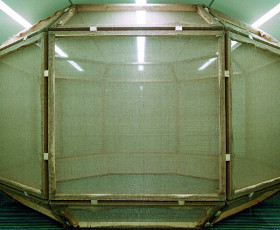Heimo Zobernig
09 Nov 2012 - 15 Apr 2013
HEIMO ZOBERNIG
Curated: Jürgen Bock
9 November 2012 – 15 April 2013
Heimo Zobernig (Mauthen, Austria, 1958) uses a critical approach to explore a variety of media, including painting, sculpture, video, installations, architectural interventions and performance art. His works seem to question the usual art narrative, in media such as architecture, design and theatre, by stirring up the underlying ideological positions and reinterpreting them with a characteristic economy of means, materials and methodologies. For this artist, reflection on the exhibition model itself, and its context, is of prime importance. In this retrospective show of his work, held at Palacio de Velázquez, the exhibition space takes on special relevance as an installation container; Zobernig subverts the usual function of the work of art by detaching it from its aura, voiding the pomp that often surrounds an exhibition and reducing the distance between the pieces of art and the public. The display devices themselves take the place of the works and space becomes an essential part of the exhibition. The palace is diaphanous, with just a few temporary walls from the previous exhibition remaining, which creates a certain antagonism between permanence-obsolescence. Zobernig, by lining up these walls, makes them into pieces of sculpture, while at the same time denouncing their temporariness. The palace structure, adorned with curtains, gives shape to a grandiloquent yet intimate stage design in which some of his smaller sculptures are displayed. This 'setting the stage' for art indicates a reflection often present in the artist's work: curtains, white screens and architectural elements such as temporary walls and carpeted floors resemble a minimalist work of art and at the same time perform a function, that of providing a display device for other works. This staging of art is thus seen as the driving force behind art. Visitors of the exhibition are called upon to participate, not just as spectators, but also questioning their own being as the link between object and discourse. In this way spectators experience a phenomenon of appropriation and are encouraged to reflect on the creation of meaning in the arts and elsewhere. In the end, the viewers, faced with these questions about the methods and manners of representation and exhibition, become the plural protagonists of the resignification of art.
Curated: Jürgen Bock
9 November 2012 – 15 April 2013
Heimo Zobernig (Mauthen, Austria, 1958) uses a critical approach to explore a variety of media, including painting, sculpture, video, installations, architectural interventions and performance art. His works seem to question the usual art narrative, in media such as architecture, design and theatre, by stirring up the underlying ideological positions and reinterpreting them with a characteristic economy of means, materials and methodologies. For this artist, reflection on the exhibition model itself, and its context, is of prime importance. In this retrospective show of his work, held at Palacio de Velázquez, the exhibition space takes on special relevance as an installation container; Zobernig subverts the usual function of the work of art by detaching it from its aura, voiding the pomp that often surrounds an exhibition and reducing the distance between the pieces of art and the public. The display devices themselves take the place of the works and space becomes an essential part of the exhibition. The palace is diaphanous, with just a few temporary walls from the previous exhibition remaining, which creates a certain antagonism between permanence-obsolescence. Zobernig, by lining up these walls, makes them into pieces of sculpture, while at the same time denouncing their temporariness. The palace structure, adorned with curtains, gives shape to a grandiloquent yet intimate stage design in which some of his smaller sculptures are displayed. This 'setting the stage' for art indicates a reflection often present in the artist's work: curtains, white screens and architectural elements such as temporary walls and carpeted floors resemble a minimalist work of art and at the same time perform a function, that of providing a display device for other works. This staging of art is thus seen as the driving force behind art. Visitors of the exhibition are called upon to participate, not just as spectators, but also questioning their own being as the link between object and discourse. In this way spectators experience a phenomenon of appropriation and are encouraged to reflect on the creation of meaning in the arts and elsewhere. In the end, the viewers, faced with these questions about the methods and manners of representation and exhibition, become the plural protagonists of the resignification of art.

